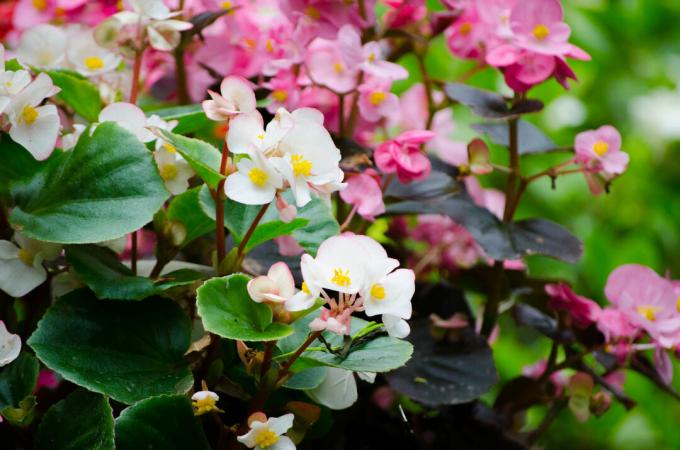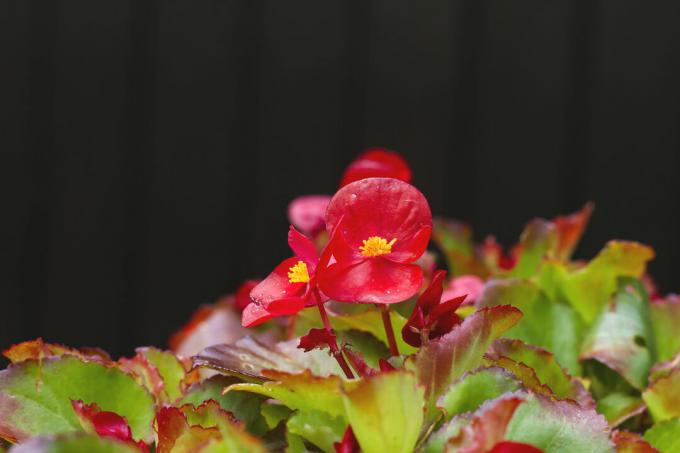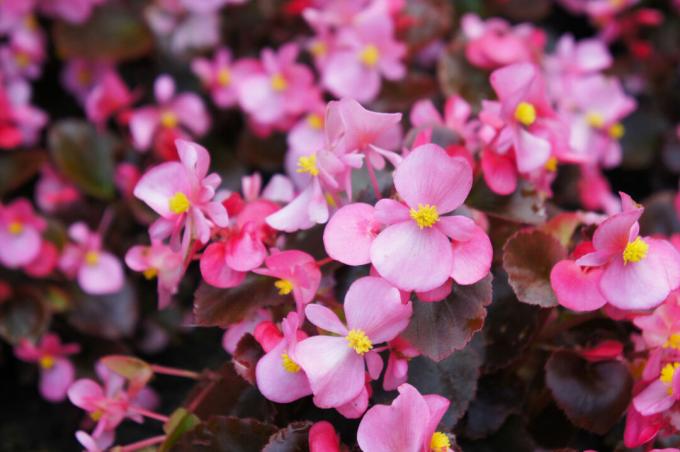The ice begonias have some special features compared to their sisters, the normal begonias. We show what you need to know about planting and caring for ice begonias.

Do you have the flowers of the polar begonia (Begonia semperflorens) have you ever looked at in detail? You may have noticed then that not all flowers look the same. Begonias do not believe in too much closeness and separate male and female elements to be on the safe side. Thus, some flowers have only male stamens, while the other flowers have only female styles. But that's not the only thing that makes ice begonias interesting contemporaries. They still have a few surprises in store.
Ice Begonias: How They Get Their Names
With the name "ice begonia" one could prematurely come to the conclusion that it would be the only frost-tolerant begonia species. In fact, ice begonias are extremely sensitive to frost. They would hardly survive a winter outdoors in Central Europe. The name probably comes more from the succulent and quickly breaking leaves of the plant. So what would be a more appropriate name? The scientific name
Begonia semperflorens puts it in a nutshell: it can be translated as "ever-blooming begonia". And indeed - once the ice begonia has started to bloom in May, it doesn't want to stop at all. Even in a nice, bright winter quarters, you won't let that stop you. Unfortunately, the numerous small flowers produce very little nectar and pollen and are therefore of little use to pollinators. Ice begonias, or perhaps more appropriately called god's eyes or bed begonias, are erect and profusely branched plants. Its bushy growth is adorned with medium to dark green leaves. But dark-leaved varieties are also available.
Ice begonias: characteristics and distinctive features
The well-known ice begonias actually come from South America. However, they do not exist in wild form, as they are a hybrid that was bred from Begonia cucullata var. hookeri and Begonia schmidtiana. With countless varieties and their white, pink or red flowers, they have easily conquered the hearts of gardeners and the gardens of Europe. Even the leaves differ in color depending on the variety. Not only green is often seen here, red and bronze-colored leaves are also not uncommon to admire. However, it is often forgotten that the ice begonia does not only do well in the bed. On the plate, its leaves and small flowers not only delight the viewer, but also spoil him with a fresh, lemony aroma. So if you want to serve something special to your guests, the flowers of the ice begonia are a wonderful addition to the salad.
If you prefer to use the plant for decorative purposes, you have numerous options, because it not only looks good in beds and borders, but also on balconies and in hanging baskets. With a maximum height of 30 centimetres, you will find enough space even in small gardens.

The most beautiful ice begonia varieties
Everyone has a slightly different taste in what the perfect Ice Begonia should look like. Countless varieties have developed over the years. The variety ranges from simple, unfilled, small flowers to filled or two-colored. You also have freedom of choice when it comes to the color of the foliage. Not only green-leaved varieties are available, but also varieties with dark or even bronze foliage.
- ‘Ostas H': This variety bears small white flowers with numerous bright yellow stamens and styles. Their foliage is colored green.
- ‘Oreb H Pink': The 'Oreb H Pink' variety also has green foliage. As the name suggests, its flowers are not white, but intense pink.
- ‘cocktail': This group of varieties surprises with dark foliage. The names of the related varieties are those of alcoholic beverages. The different types of 'Rum', 'Whisky' or 'Gin' have a wide variety of red, white and pink tones.
- ‘Volumia Rose bicolor': This variety comes in two colors. Its white flowers are decorated with a wonderful pink border and really come into their own. The foliage of this variety is green.
- ‘doublet': Ice begonias of this series are particularly beautiful because of their double flowers. They come in all colors and can have both bronze and green foliage.
If you are interested in other begonia species and varieties, you will find them in our overview article.

Plant ice begonias
Do not plant out the flowering ice begonias until mid-May, when the ice saints are over. Then you can be sure that late frosts will no longer endanger your plant. If you keep a distance of about 20 centimeters between the individual plants, you can plant veritable seas of flowers. With a skilful combination of different flower colors, even patterns and motifs can be developed. Since ice begonias bloom throughout the summer months and like it sunny, they are also often planted on graves. A detailed guide to planting begonias can be found here.

Caring for ice begonias: You should pay attention to this
Ice begonias are uncomplicated and easy to manage. The only thing you should be careful with is touching it, because the fleshy leaves and shoots break easily. Keep the plants moist, but avoid waterlogging. It is best to always wait until the soil above ground has dried before watering the next time. For fertilization it is sufficient to give the plant a portion of compost, manure or long-term fertilizer like ours in the spring when planting Plantura organic flower fertilizer to administer.
Ice begonias overwinter
Although the tropical plants are usually planted as annuals in Germany due to their sensitivity to frost, there is nothing to be said against overwintering in warm weather. It's a waste of the plant, the resources and the money that would otherwise be wasted. In addition, ice begonias bloom even during the cold months with a warm winter. Simply dig up the plant's root balls and place them in a pot. Now they can be optimally overwintered at around 16 to 20 °C, for example in the bright stairwell.
Alternatively, you can cut the plants down to a few centimeters in autumn Put the root ball in a box with slightly moist soil and in a frost-free but cool basement hibernate. Only in March should you place the plants in the light and start watering again.

